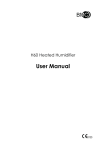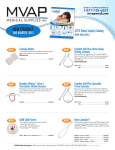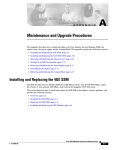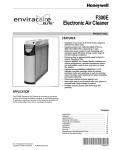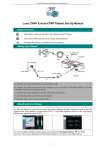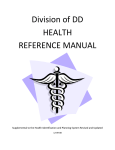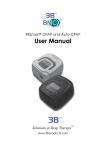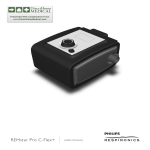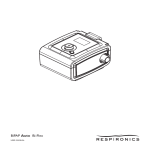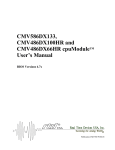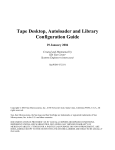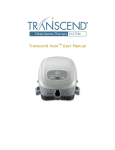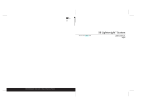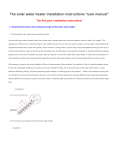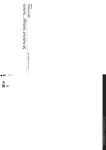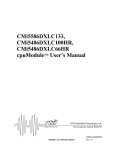Download Luna CPAP /AutoCPAP User Manual
Transcript
™ CPAP and Auto-CPAP System User Manual E-20 System User Manual V1.0 Table of Contents 1. Introduction ·····························································································1 2. Symbols ···································································································1 2.1 Control Buttons ···············································································1 2.2 Device Symbols ··············································································1 3. Warning, Caution and Important Tip ···························································2 4. Intended Use ····························································································2 5. Contraindications ·····················································································3 6. Specifications ···························································································4 7. Available Therapies ···················································································5 8. Glossary ···································································································6 9. Model······································································································7 10. Package Contents ··················································································7 11. System Features ······················································································8 12. First Time Setup························································································9 12.1 Placing the Device ········································································9 12.2 Installing the Air Filter and Filter Cap ··············································10 12.3 Connecting to Power ··································································10 12.4 Assembling the Air hose and Mask ················································11 12.5 Using Oxygen with the Device ······················································12 12.6 Inserting the SD Card ···································································12 12.7 Using the H60 Heated Humidifier ···················································13 12.8 Starting Treatment ·······································································13 13. Routine Use ··························································································14 13.1 Connecting the Air hose ······························································14 13.2 Adjusting the Air hose ··································································14 13.3 Turning on the Airflow ··································································14 13.4 Heating the Water in the Humidifier ···············································14 13.5 Using the Ramp Button·································································14 13.6 Turning the Device Off ·································································15 14. Navigating the Patient Menu··································································15 14.1 Steps to Navigating the Patient Menu ···········································15 14.1.1 Accessing the Main Interface ············································15 14.1.2 Bringing up the Initial Setup Interface ·································15 14.1.3 Accessing the Setup Interface ···········································16 14.1.4 Selecting Options ·····························································16 14.1.5 Adjusting Options ·····························································16 14.1.6 Confirming Adjustments ····················································17 14.1.7 Turning Pages ··································································17 14.1.8 Exiting the Patient Menu ····················································17 14.2 Options of the Patient Menu and Corresponding Descriptions··········19 15. Alert·····································································································20 16. Cleaning ······························································································21 16.1 Cleaning the Mask and Headgear ················································21 16.2 Cleaning the Water Chamber of the Humidifier ······························21 16.3 Cleaning the Enclosure ································································21 16.4 Cleaning the Air hose ··································································22 16.5 Replacing the Air Filter ·································································22 17. Traveling with the Device ·······································································23 18. Reordering ···························································································24 19. Technical Support ·················································································24 20. Disposal ·······························································································24 E-20 System User Manual V1.0 21. Troubleshooting ····················································································25 21.1 Common Problems in Patients and Corresponding Solutions ············25 21.2 Common Problems in the Device and Corresponding Solutions ·······27 22. EMC Requirements ················································································28 23. Limited Warranty ···················································································32 E-20 System User Manual V1.0 1. Introduction Thank you for your purchase of the 3B Luna™ CPAP / Auto-CPAP System. This User Manual will introduce you to your device. Please read it carefully. If, during use, you experience any difficulties or problems, please contact your homecare provider or physician. 2. Symbols 2.1 Control Buttons Ramp Button Mute Button Knob 2.2 Device Symbols Operating Instructions Type BF Applied Part (mask) Class II (Double Insulated) AC Power DC Power IP22 ≥ 12.5 mm Diameter, Dripping (15ºtilted) Hot Surface Serial Number of the Product Manufacturer European CE Declaration of Conformity SD Card Water Filling Prohibited Here Water Inlet Directional Indicator for Removing the Water Inlet Cap Directional Indicator for Screwing the Water Inlet Cap 1 / 32 E-20 System User Manual V1.0 3. Warning, Caution and Important Tip WARNING! Indicate the possibility of injury to the user or operator. CAUTION! Indicate the possibility of damage to the device. IMPORTANT TIP! Place emphasis on an operating characteristic. Warnings, Cautions, and Important Tips appear throughout this manual as they apply. 4. Intended Use The 3B and BMC CPAP and Auto CPAP Systems are intended to deliver positive pressure for the treatment of Obstructive Sleep Apnea. The optional integrated humidifier is indicated for the humidification and warming of air from the flow generator. These devices are intended for single patient use by prescription in the home or hospital / institutional environment on adult patients. WARNINGS! • This device is intended for adult use only. • This device is not intended for life support. • The instructions in this manual are not intended to supersede established medical protocols. CAUTION! • This device is restricted to sale by or on the order of a physician. • The device is intended for use by operators trained or experienced in similar equipment. • The patient is an intended operator. • Cleaning can be performed by the patient. IMPORTANT! • Read and understand the entire user manual before operating this system. If you have any questions concerning the use of this system, contact your home care provider or health care professional. 2 / 32 E-20 System User Manual V1.0 5. Contraindications Studies have shown that the following pre-existing conditions may contraindicate the use of positive airway pressure therapy for some patients: Absolute Contraindications: pneumothorax, mediastinal emphysema; cerebrospinal fluid leak, traumatic brain injury, or pneumocephalus; shock caused by a variety of conditions before treatment; active epistaxis; upper gastrointestinal bleeding before treatment; coma or impaired consciousness making the use of mask during therapy impossible; giant vocal fold polyp, etc. Relative Contraindications: severe coronary heart disease complicated with left ventricular failure, acute otitis media, excessive respiratory secretions and weak cough, weak spontaneous breathing, nasal or oral tracheal intubation and tracheotomy, severe nasal congestion caused by a variety of conditions, lung bullae, and allergies to breathing masks, etc. The following side effects may occur during treatment: - Dryness of the mouth, nose and throat - Abdominal bloating - Ear or sinus discomfort - Eye irritation - Skin irritation due to the use of a mask - Chest discomfort IMPORTANT! • An irregular sleep schedule, alcohol consumption, obesity, sleeping pills, or sedatives may aggravate your symptoms. • Please use the mask which meets ISO17510-2:2009. CAUTION! • Contact your health care professional if symptoms of sleep apnea recur. Contact your health care professional if you have any questions concerning your therapy. 3 / 32 E-20 System User Manual V1.0 6. Specifications Device Size Dimensions: 170 mm × 196 mm × 118 mm, or 290 mm × 196 mm × 134 mm (with the humidifier) Weight: 1.5 kg, or 2.5 kg (with the humidifier) Product Use, Transport and Storage Operation Temperature: Humidity: Transport and Storage 5°C to 35°C (41˚F to 95˚F) 15% to 93% Non-condensing Atmospheric Pressure: 760 ~ 1060 hPa -25°C to 70°C (-13˚F to 158˚F) up to 93% Non-condensing 760 ~ 1060 hPa Mode of Operation Continuous Work Mode For E-20C system: CPAP For E-20A system: CPAP, Auto SD Card With a capacity ≥ 2 G, the SD card can record patient data and fault information. Furthermore, the language pack stored on the SD card enables you to change the language of the device. AC Power Consumption 100 ~ 240 V AC, 50 / 60 Hz, 2.0 A max Type of Protection Against Electric Shock Class II Equipment Degree of Protection Against Electric Shock Type BF Applied Part Degree of Protection Against Ingress of Water IP22 Pressure Range 4 to 20 hPa (in 0.5 hPa increments), ≤ 30 hPa under single fault conditions. Pressure Display Accuracy ±(0.5 hPa+4%) Pressure Stability 4 to 20 hPa (±1 hPa) Ramp The ramp time ranges from 0 to 60 minutes 4 / 32 E-20 System User Manual V1.0 Sound Pressure Level < 30 dB, when the device is working at the pressure of 10 hPa. Sound Power Level < 38 dB, when the device is working at the pressure of 10 hPa. Maximum Flow 4 9 15 20 80 92 91 96 Test Pressure (hPa) Average Flow at the Patient Connection Port (L/min) Air Hose Length: 6 ft. (1.83 m) The Form and the Dimensions of the Patient Connection Port The 22 mm conical air outlet complies with ISO 5356-1 7. Available Therapies The device delivers the following therapies: CPAP – Delivers Continuous Positive Airway Pressure; CPAP maintains a constant level of pressure throughout the breathing cycle. If your health care professional has prescribed ramp for you, you can press the Ramp Button to reduce the pressure and then gradually increase the pressure to the therapeutic pressure setting so that you can fall asleep more comfortably. Auto – Delivers CPAP therapy and provides an air pressure no less than the prescribed one based on the patient’s needs. 5 / 32 E-20 System User Manual V1.0 8. Glossary Apnea A condition marked by the cessation of spontaneous breathing. Auto-CPAP Adjust CPAP pressure automatically to improve patient comfort based on monitoring of apnea and snoring events. Auto Off When this feature is enabled, the device automatically discontinues therapy whenever the mask is removed. Auto On When this feature is enabled, the device automatically initiates therapy when you breathe into the mask. CPAP Continuous Positive Airway Pressure. iCode A feature that is intended to give access to compliance and therapy management information. The ―iCode‖ consists of six separate codes displayed in the Patient Menu. iCode I displays sequences of characters, and iCode II displays two-dimensional codes. LPM Liters Per Minute. OSA Obstructive Sleep Apnea. Patient Menu The display mode in which you can change patient-adjustable device settings, such as the starting pressure for the Ramp feature. Ramp A feature that may increase patient comfort when therapy is started. It can reduce pressure and then gradually increase the pressure to the prescription setting so the patient can fall asleep more comfortably. Reslex A therapy feature that is enabled by your home care provider to provide pressure relief during exhalation. Standby State The state of the device when power is applied but the airflow is turned off. 6 / 32 E-20 System User Manual V1.0 9. Model Product Description Model E-20C-H-O E-20A-H-O Product Contents Main device (2.4-inch LCD), Heated Humidifier (H60) Main device (3.5-inch LCD), Heated Humidifier (H60) Work Mode Size (mm) Weight (kg) CPAP 290 (W) × 196 (D) × 134 (H) 2.5 CPAP Auto 290 (W) × 196 (D) × 134 (H) 2.5 10. Package Contents After unpacking the system, make sure you have everything shown here: No. 1 2 3 4 5 6 7 8 9 10 Articles Main Device Heated Humidifier Shield Air Filter Power Adapter Power Cord SD Card Carrying Case User Manual Quick Operation Manual Qty. 1 1 1 2 1 1 1 1 1 1 Notes Optional Optional All parts and accessories are not made with natural rubber latex. The expected service life of the main device is 5 years. IMPORTANT! • If any of the above parts are missing, contact your home care provider. • Contact your home care provider for additional information on the available accessories of this device. When using optional accessories, always follow the instructions enclosed with the accessories. WARNING! • The use of inappropriate masks and accessories may affect the performance of the device and impair the effectiveness of therapy. 7 / 32 E-20 System User Manual V1.0 11. System Features Humidifier Indicator Display Screen Mute Button Power Indicator Knob Air Outlet Ramp Button Humidifier Connector Shield Fig. 11-1 Name Function Humidifier Indicator Indicate the humidity level. There are five levels in total. The number of blue indicator lights that light up is directly proportional to the humidity level. If none of the indicator lights light up, it means the humidifier is turned off Mute Button Press this button to mute the alert. However, if the problem causing the alert is not solved, the alert will sound again two minutes later Knob Ramp Button Start treatment and adjust device settings Enable the Ramp feature Display Screen Display menus for operation, messages, monitoring data, etc. Power Indicator Indicate the power supply status with the green indicator light Air Outlet Deliver pressurized air; connected to the air hose or the air inlet of the humidifier Humidifier Connector Provide power to the humidifier which is connected to the main device Shield Connect the humidifier to the main device after this shied is removed 8 / 32 E-20 System User Manual V1.0 SD Card Slot Communications Port DC Inlet Filter Cap Fig. 11-2 Name SD Card Slot Communications Port DC Inlet Filter Cap Function Insert the SD card into this slot Connected to external equipment An inlet for the DC power supply Place the cap on the air filter, which is used to filter dust and pollen in the air entering the device 12. First Time Setup 12.1 Placing the Device Place the device on a firm, flat surface. WARNINGS! • If the device has been dropped or mishandled, if the enclosure is broken, or if water has entered the enclosure, disconnect the power cord and discontinue use. Contact your home care provider immediately. • If the room temperature is warmer than 95˚F (35°C), the airflow produced by the device may exceed 109.4˚F (43°C). The room temperature must be kept below 95˚F (35°C) while the patient uses the device. CAUTIONS! • If the device has been exposed to either very hot or very cold temperatures, allow it to adjust to room temperature (approximately 2 hours) before beginning setup. • Make sure the device is away from any heating or cooling equipment (e.g., forced air vents, radiators, air conditioners). • The device is not suitable for use in high humidity environments. Make sure that no water enters the device. • Make sure that bedding, curtains, or other objects (such as pests) are not blocking or entering the filter or vents of the device. • Keep pets or children away from the device. • To avoid explosion, this device must not be used in the presence of flammable gases (e.g. anesthetics). 9 / 32 E-20 System User Manual V1.0 • Tobacco smoke may cause tar build-up within the device, leading to the malfunctioning of the device. • Air must flow freely around the device for it to work properly. 12.2 Installing the Air Filter and Filter Cap (1) Attach the air filter to the filter cap, as shown in Fig. 12-1. Air Filter Filter Cap Fig. 12-1 (2) Install the filter cap containing the air filter to the main device, as shown in Fig. 12-2. Fig. 12-2 CAUTION! • The air filter must be in place when the device is operating. • Installing the air filter and filter cap, device must be unplugged. 12.3 Connecting to Power (1) Insert the plug of the power adapter into the DC Inlet on the back of the device; (2) Connect the power cord to the power adapter; (3) Plug the other end of the power cord into the power outlet. DC Inlet Main Device Power Adapter Power Cord Fig. 12-3 10 / 32 E-20 System User Manual V1.0 WARNINGS! • The device is powered on for use when the power cord and power adapter is connected. The Knob turns the blower On / Off. • Use of the device at an AC voltage beyond the stated range (see Section 6 ―AC Power Consumption‖) may damage the device or cause device failure. CAUTION! • Inspect the power cord often for any signs of damage. Replace a damaged cord immediately. IMPORTANT! • After interruption and restoration of the power supply, the device will restore its pre-interruption working status automatically. • To remove AC power, disconnect the power cord from the power outlet. 12.4 Assembling the Air hose and Mask (1) Connect one end of the air hose to the air outlet of the main device, as shown in Fig. 12-4. If the main device is used with a humidifier, connect one end of the air hose to the air outlet of the humidifier, as shown in Fig. 12-5. Air Outlet Tube Fig. 12-4 Air Outlet Tube Fig. 12-5 (2) Connect the other end of the air hose to the mask according to the user manual for the mask. Wear the mask. WARNINGS! • If you are using a mask with a built-in exhalation port, connect the mask’s connector to the air hose. • If you are using a mask with a separate exhalation port, connect the air hose to the exhalation port. Position the exhalation port so that the vented air is blowing away from your face. Connect the mask’s connector to the exhalation port. 11 / 32 E-20 System User Manual V1.0 • If you are using a full-face mask (a mask covering both your mouth and nose), the mask must be equipped with a safety (entrainment) valve. • In order to minimize the risk of CO2 rebreathing, the patient should observe the following instructions: - Do not wear the mask for more than a few minutes while the device is not operating. - Use only masks with vent holes. Do not block or try to seal the vent holes in the exhalation port. 12.5 Using Oxygen with the Device Oxygen may be added at the mask connection. Please observe the instructions listed below when using oxygen with the device. WARNINGS! • Connect the oxygen air hose to the oxygen inlet of the mask. • The oxygen supply must comply with the local regulations for medical oxygen. • Turn on the device before turning on the oxygen. Turn off the oxygen before turning off the device. Explanation of Warning: When the device is turned off, but the oxygen flow still exists, oxygen may accumulate within the device's enclosure and pose a fire hazard. Turning off the oxygen before turning off the device will prevent oxygen accumulation in the device and reduce the risk of fire. This warning applies to most CPAP devices. • Oxygen supports combustion. Keep the device and the oxygen container away from heat, open flames, any oily substances, or other sources of ignition. DO NOT smoke in the area near E-20C / E-20A or the oxygen container. • Sources of oxygen should be located more than 1 m from the device. 12.6 Inserting the SD Card Insert the SD card into the SD Card Slot, as shown in Fig. 12-6. SD Card Slot Fig. 12-6 If the SD card is inserted correctly, a symbol indicating correct insertion will appear in the Main Interface on the screen of the device, as shown in Fig. 12-7. 12 / 32 E-20 System User Manual V1.0 Fig. 12-7 If the SD card is inserted incorrectly or not inserted, a symbol indicating incorrect insertion or no SD card present will appear in the Main Interface on the screen of the device, as shown in Fig. 12-8. Fig. 12-8 CAUTION! • To avoid data loss or any damage to the SD card, the SD card can only be removed after the main device stops delivering air. 12.7 Using the H60 Heated Humidifier The H60 Heated Humidifier is available from your home care provider. The humidifier may reduce nasal dryness and irritation by adding moisture (and heat if applicable) to the airflow. For detailed information about the heated humidifier, please see the user manual for the heated humidifier. 12.8 Starting Treatment Connect the device to a power outlet, press the Knob , and the device will start delivering air. WARNINGS! • Be sure to follow your physician’s instructions on adjusting the settings! To order any accessories not included with this device, contact your equipment supplier. • DO NOT connect any ancillary equipment to this device unless recommended by your homecare provider or your physician. If you suffer from chest discomfort, 13 / 32 E-20 System User Manual V1.0 shortness of breath, stomach bloating, or severe headache when using the device, contract your physician or qualified medical personnel immediately. 13. Routine Use 13.1 Connecting the Air hose Connect the power cord, power adapter, and air hose properly according to the instructions in the First Time Setup (Chapter 12). Connect the mask and headgear according to the user manual for the mask. CAUTION! • Before each use, examine the air hose for any damage or debris. If necessary, clean the air hose to remove the debris. Replace any damaged air hose. Make sure that the mask does not leak. 13.2 Adjusting the Air hose Lie down on your bed, and adjust the air hose so it is free to move if you turn during sleep. Adjust the mask and headgear until you have a comfortable fit and until there are no airflow leaks into your eyes. 13.3 Turning on the Airflow Press the Knob to turn on the airflow. The screen will display treatment pressure and other information. 13.4 Heating the Water in the Humidifier Pay attention to the humidifier indicator lights when using the device with a humidifier. The indicator lights indicate the On / Off state of the humidifier. It is off when all indicator lights go out. CAUTION! • Observe the water level of the water chamber before using the humidifier. Make sure there is sufficient water in the water chamber, and avoid heating the humidifier with an empty water chamber. 13.5 Using the Ramp Button Every time the Ramp Button is pressed, the pressure will drop to the initial pressure, and then gradually rise to the prescribed treatment pressure according to the preset ramp time, so as to make the patient fall asleep easily. The screen displays a real-time countdown of the remaining ramp time in minutes. CAUTIONS! • You can press the Ramp Button as often as you wish during sleep. 14 / 32 E-20 System User Manual V1.0 • The ramp feature is not prescribed for all users. 13.6 Turning the Device Off Take off the mask and headgear, press and hold the Knob for two seconds, and the device will stop delivering air. Disconnect the power cord from the power outlet to power off the device. CAUTIONS! • Do not position the device so that it is difficult to operate the disconnection device. • To isolate the device from the supply mains, disconnect the plug. 14. Navigating the Patient Menu 14.1 Steps to Navigating the Patient Menu 14.1.1 Accessing the Main Interface Connect the power cord and power adapter properly. The screen displays the Main Interface shown in Fig. 14-1 (applies to E-20A-H-O), or the Main Interface shown in Fig. 14-2 (applies to E-20C-H-O). Fig. 14-1 Fig. 14-2 14.1.2 Bringing up the Initial Setup Interface From the Main Interface shown in Fig. 14-1 or Fig. 14-2, or when the device delivers air, press and hold the Ramp Button for three seconds. The screen displays the Initial Setup Interface of the Patient Menu, as shown in Fig. 14-3. 15 / 32 E-20 System User Manual V1.0 Fig. 14-3 The first icon on the left side of the screen indicates the Main Interface, and the second icon indicates the Initial Setup Interface. As you turn the Knob , the cursor switches between the two icons, and the interface displayed on the screen changes accordingly. 14.1.3 Accessing the Setup Interface When the cursor is on the icon , the screen displays the Setup Interface. Access the Setup Interface by pressing the Knob . The first option on the Setup Interface is then displayed in blue, as shown in Fig. 14-4. Fig. 14-4 14.1.4 Selecting Options As you turn the Knob clockwise, the cursor moves downwards from one option to another. As you turn it counterclockwise, the cursor moves upwards. When the cursor is on a certain option, press the Knob , and the option is then displayed in yellow, meaning that the option can now be adjusted, as shown by the Humidifier option in Fig. 14-5. Fig. 14-5 14.1.5 Adjusting Options Adjust the option by turning the Knob is selected. As you turn the Knob . As shown in Fig. 14-5, the Humidifier option clockwise, the numbering increases, indicating a higher humidity level. As you turn the Knob 16 / 32 counterclockwise, the numbering E-20 System User Manual V1.0 decreases, indicating a lower humidity level. At this moment, the Humidifier option is still displayed in yellow, as shown in Fig. 14-6. Fig. 14-6 14.1.6 Confirming Adjustments Confirm your adjustment to an option by pressing the Knob . The option is then displayed in blue, as shown in Fig. 14-7. Fig. 14-7 14.1.7 Turning Pages When the cursor is on Mask Type, the last option shown in Fig. 14-7, the remaining options will appear on a new page if you continue to turn the Knob clockwise, as shown in Fig. 14-8. Fig. 14-8 Note: are page turning symbols. 14.1.8 Exiting the Patient Menu (1) Returning to the Initial Setup Interface Move the cursor to the Back option by turning the Knob 17 / 32 , as shown in Fig. 14-9. E-20 System User Manual V1.0 Fig. 14-9 Press the Knob , the cursor jumps to the second icon on the left side of the screen. The screen displays the Initial Setup Interface, as shown in Fig. 14-10. Fig. 14-10 (2) Returning to the Main Interface Move the cursor to the Home option by turning the Knob , as shown in Fig. 14-11. Fig. 14-11 Press the Knob to exit the Patient Menu. The screen will display the Main Interface shown in Fig. 14-1 or Fig. 14-2. 18 / 32 E-20 System User Manual V1.0 14.2 Options of the Patient Menu and Corresponding Descriptions Option Range Description Off, 1 ~ 5 There are five humidity levels available. As the numbering increases, the humidity rises accordingly. ―Off‖ means the humidifier is turned off. The default setting is ―2‖ Off, 1 ~ 3 This feature enables the device to automatically reduce the treatment pressure when the patient exhales, so as to make the user more comfortable. The higher the numbering is, the more pressure the device reduces. ―Off‖ means this feature is disabled. The default setting is ―Off‖ 0 - Max Ramp In order to increase comfort and help the patient fall asleep easily, the pressure can increase gradually, when the Ramp feature is enabled. The ramp time during which the initial pressure rises to the prescribed treatment pressure can be adjusted. As you turn the Knob to the nearest point, the numbering increases or decreases by five minutes. The default setting is ―10 minutes.‖ The screen displays a real-time countdown of the remaining ramp time in minutes Delay On / Off When the humidifier is on, this feature allows the airflow to continue for about 15 minutes at a low pressure (about 2 hPa) after you press the Knob to discontinue treatment. This will blow off the vapor left in the humidifier to avoid any damage to the device. When this feature is set to ―Off,‖ which means it is disabled, the airfolw stops delivering air instantly after you press the Knob . The default setting is ―Off‖ Date 2000-01-01 — 2099-12-31 Setting date by adjusting this option Time —— Setting time by adjusting this option Brightness High / Low Setting screen brightness by adjusting this option. The default setting is ―High‖ Mask Type Full Face; Nasal; Pillow; Other There are three mask types available, namely Full Face (full-face mask), Nasal (nasal mask), and Pillow (nasal pillow mask). The default mask type is ―Nasal,‖ but the patient can choose other suitable masks as well. When selecting masks other than the above three types of masks, the patient can identify the masks as Other Run Time 0 ~ 50000 h Run Time displays how long has the device been used by the user. The run time can be erased iCode iCode I, iCode II iCode provides access to the patient's compliance data during a recent time period. The iCode I mode displays data in sequences of characters, and the iCode II mode displays data in two-dimensional codes Humidifier Reslex Ramp Time 19 / 32 E-20 System User Manual V1.0 15. Alert Alert Message Power Failure!!! Description An audible alert will sound if the device is accidentally disconnected from power when it is delivering air. Note: (1) The alert will not sound if power failure occurs when the device is in standby state. (2) No alert message on the screen during a power failure Device Fault!!! An audible alert will sound if no airflow comes out of the machine; the screen will display ―Device Fault!!!‖ Leak!! When the airflow is on, an audible alert will sound if the air leak rate exceeds 150 L/min; the screen will display ―Leak!!‖ Low Input Voltage!! If you use a battery rather than an external power adapter to power the device, an audible alert will sound when the battery is low; the screen will display ―Low Input Voltage!!‖ Humidifier Failure!! When humidifier is applied, an audible alert will sound when the humidifier fails to work; the screen will display ―Humidifier Failure!!‖ Please Change Filter! When the Filter Alert feature is enabled, an audible alert will sound if an air filter has been used for more than six months; the screen will display ―Please Change Filter!‖ SD Card Full! The screen will display ―SD Card Full!‖ if the SD card has reached its maximum capacity Reinsert SD card! The screen will display ―Reinsert SD card!‖ if the SD card fails to work 20 / 32 E-20 System User Manual V1.0 16. Cleaning WARNINGS! • Regular cleaning of the device and its accessories is very important for the prevention of respiratory infections. • To avoid electric shock, always unplug the device before cleaning. • Use washing liquid that is nontoxic to humans and does not cause allergies in humans. • Follow the manufacturer's instructions on cleaning the mask and air hose and on determining the frequency of cleaning. • Before cleaning, check whether the device has been disconnected from the power supply, whether the power cord has been unplugged, and whether the water chamber of the humidifier has cooled down. Make sure the heater plate has cooled down to room temperature, so you do not get burned. • The device shall not be serviced or maintained while in use with a patient. • Sterilization of this device and its components other than recommended is not permitted. CAUTIONS! • Overheating of the materials could lead to early fatigue of these materials. • Do not use solutions containing chlorinated lime, chlorine, or aromatic to clean the device and its accessories. Liquid soap containing the humidifying agent or antimicrobials should not be used either. These solutions may harden cleaned materials or reduce their life. • Do not clean or dry the device and its accessories when the temperature is higher than 80°C (176˚F). High temperatures could reduce product life. • Do not immerse the device in any fluids. 16.1 Cleaning the Mask and Headgear For details, refer to the cleaning instructions in the user manual for the mask. 16.2 Cleaning the Water Chamber of the Humidifier For details, refer to the cleaning instructions in the user manual for the humidifier. 16.3 Cleaning the Enclosure Wipe the surface of the device with a soft, slightly damp cloth. CAUTION! • The device can only be used after the enclosure is dry, so that no moisture enters the device. 21 / 32 E-20 System User Manual V1.0 16.4 Cleaning the Air hose (1) Remove the air hose from the device and mask before cleaning. (2) Clean the air hose in warm water which contains washing liquid, and then rinse it in clean water thoroughly. (3) After cleaning, air-dry the air hose in a cool, well-ventilated area, and avoid direct sunlight. It takes approximately 30 minutes to completely air-dry the air hose. Check whether the air hose is completely dry before re-use. 16.5 Replacing the Air Filter (1) Open the air filter cap to remove the air filter. (2) Put the new air filter in the filter area, and then place the filter cap back properly. CAUTIONS! • To avoid material damage, do not place the spare air filter in direct sunlight, humid environments, or temperatures below the freezing point. The air filter should be replaced every 6 months (It may be replaced more frequently based on actual sanitary conditions). • Operating the device with a dirty air filter may stop it from working properly and may cause damage to the device. • Replacing the air filter and filter cap, device must be unplugged. 22 / 32 E-20 System User Manual V1.0 17. Traveling with the Device CAUTIONS! • Empty the water chamber of the humidifier before packing the device for your trip; in order to prevent any remaining water from entering the device. • Using the device at an incorrect elevation setting could result in airflow pressures higher than the prescribed setting. Always verify the elevation setting when traveling or relocating. • If the device is used when the atmospheric pressure is out of the stated range (See Section 6), the accuracy of the leakage alert will be affected. (1) Use the 3B / BMC carrying case to carry the device and accessories along with you. Do not put them in your checked baggage. (2) This device operates on power supplies of 100 ~ 240 V and 50 / 60 Hz, and is suitable for use in any country in the world. No special adjustment is necessary, but you will need to find out the types of the power sockets in your destination. Bring, if necessary, a power socket adaptor which can be bought in electronics stores. (3) Remember to bring a spare air filter and the emergency documents (filled and signed by your physician) about this device. If you plan to travel by air, remember to bring the multi-language emergency documents about respiratory therapy, in case that the border and customs officers in your destination country inspect the device. With the emergency documents, you can prove to them that it is a medical device. (4) Security Stations: For convenience at security stations, there is a note on the bottom of the device stating that it is medical equipment. It may be helpful to bring this manual along with you to help security personnel understand the device. 23 / 32 E-20 System User Manual V1.0 18. Reordering Contact your home care provider to order accessories or replacement filters. The device does not require routine servicing. WARNINGS! • If you notice any unexplained changes in the performance of the device, if it is making unusual or harsh sounds, if it has been dropped or mishandled, if the enclosure is broken, or if water has entered the enclosure, discontinue use. Contact your home care provider. • If the device malfunctions, contact your home care provider immediately. Never attempt to open the enclosure of the device. Repairs and adjustments must be performed by 3B-authorized service personnel only. Unauthorized service could cause injury, invalidate the warranty, or result in costly damage. • If necessary, contact your local authorized dealer or 3B Medical, Inc. for technical support and documents. 19. Technical Support Please contact 3B directly if you need the circuit diagram of the device and the list of components for certain purposes such as maintenance or connection to other equipment. 3B will provide the circuit diagram and / or other technical documents in whole or in part according to your needs. 20. Disposal When the device reaches the end of its service life, dispose of the device and packaging in accordance with local laws and regulations. 24 / 32 E-20 System User Manual V1.0 21. Troubleshooting The table below lists common problems you may have with the device and possible solutions to those problems. If none of the corrective actions solve the problem, contact your home care provider. 21.1 Common Problems in Patients and Corresponding Solutions Problem Possible Cause Dry, cold, runny, and blocked nose; having a cold The nose reacts to the airflow and cold. Due to fast airflow, the air becomes cold, leading to nasal mucosa irritation and subsequent dryness and swelling Dry mouth and throat Probably because the patient sleeps with his or her mouth open, and the pressurized air goes out via the mouth, leading to nasal and throat dryness Eye irritation Facial reddening The mask size or model may not be correct, or the mask is not positioned correctly, thereby leading to air leakage Solution (s) Increase the humidity setting of the humidifier. Contact your physician, and continue treatment unless the physician suggests the opposite Use a chin strap to prevent the mouth from opening during sleep, or use a full-face mask. Contact your physician for details Narrow the distance between the forehead support of the mask and the forehead. Note that adjusting the mask too tight may leave markings on the patient’s face. Add additional filling to the mask so it does not leak. Contact your equipment supplier for an appropriate mask. Add additional filling to the mask if necessary Mask cushion (the soft part of the mask) hardens Replace cushion The mask is too tight Loosen the headgear The distance between the forehead support of the mask and the forehead is not correct Try a different distance. The angle and size of the forehead support differ according to the type of masks Wrong mask size Contract your equipment supplier for a correct-size mask 25 / 32 the mask or mask E-20 System User Manual V1.0 Contact your physician and equipment supplier. The patient is allergic to the materials of the mask Use a mask which is not made with natural rubber latex. Place a lining between the skin and mask Turn the humidity setting down, or raise the room temperature. Place the air hose under the quilt, or use the air hose cover. Water in mask When the humidifier is used, the humidified air tends to condense in the cold air hose and mask if the room temperature is low Nasal, sinus, or ear pain Sinus or middle inflammation Discomfort due to inability to adapt to the treatment pressure The patient will feel uncomfortable when the treatment pressure is higher than 13 hPa. However, the treatment pressure is determined according to the patient's conditions, and cannot treat sleep apnea if the treatment pressure is set too low Obstructive sleep apnea symptoms recur Probably because the patient sleeps with his or her mouth open, and the pressurized air goes out via the mouth, leading to blockage in the respiratory tract Use a chin strap to prevent the mouth from opening during sleep, or use a full-face mask. Contact your physician for details The device is too noisy The air hose is connected properly Reconnect the air hose properly Air delivered from the device is abnormally hot ear not The air inlet of the device may be partially blocked, leading to insufficient airflow into the device 26 / 32 Hang the air hose loosely, and the lowest part of the air hose should be lower than the patient's head Contact your immediately physician It takes a maximum of four weeks to adapt to pressurized air. Relax and breathe through the nose. If the problem still exists, contact your physician Replace the air filter (see 16.5 Replacing the Air Filter), and clean the air inlet Place the device in an area where air flows freely, and make sure the device is at least 20 centimeters away from the wall, curtain, or other things E-20 System User Manual V1.0 21.2 Common Problems in the Device and Corresponding Solutions Problem Possible Cause Solution (s) The Auto On / Off feature is enabled Take a few deep breaths with the mask on, and the device will start automatically Power is not connected properly Ensure that the power cord, power adapter, and the device are connected properly There is no voltage Check whether a power outage occurs by turning on a light or other means. If you are sure the fuse in the device is broken, contact your equipment supplier for repair Cannot find any cause Contact supplier The air hose is connected properly Reconnect properly The device does not work when it is turned on The device is working, but the pressure inside the mask differs from the set treatment pressure not your the equipment air hose There may be holes in the mask or pressure sensing air hose Contact supplier your equipment It is a faulty device Contact supplier your equipment The air inlet of the device may be blocked Replace the air filter (see 16.5 Replacing the Air Filter), and clean the air inlet. Make sure the air inlet is unblocked The treatment pressure has been changed accidentally Contact your physician When the Ramp feature is enabled, it takes some time for the initial pressure to rise to the treatment pressure. This is normal If necessary, disable the Ramp feature, or set the ramp time shorter After the device is turned on, the screen displays intermittently, or displays nothing at all The operating system of the device needs to be readjusted or restarted Unplug the power cord of the device, and re-plug it 20 seconds later The device is in standby, and will not start The operating system of the device needs to be readjusted or restarted Unplug the power cord of the device, and re-plug it 20 seconds later The device produces very low pressures 27 / 32 E-20 System User Manual V1.0 22. EMC Requirements Guidance and manufacturer's declaration - electromagnetic emissions The device is intended for use in the electromagnetic environment specified below. The user of the device should ensure that it is used in such an environment. Emissions Test RF emissions CISPR 11 RF emissions CISPR 11 Compliance The device uses RF energy only for its internal function. Therefore its RF emissions are very low and are not likely to cause any interference in nearby electronic equipment Group 1 Class B Harmonic emissions IEC 61000-3-2 Class A Voltage fluctuations / flicker emissions IEC 61000-3-3 Complies Electromagnetic Environment Guidance The device is suitable for use in all establishments including domestic establishments and those directly connected to the public low-voltage power supply network that supplies buildings used for domestic purposes 28 / 32 E-20 System User Manual V1.0 Guidance and manufacturer's declaration - electromagnetic immunity The device is intended for use in the electromagnetic environment specified below. The user of the device should make sure that it is used in such an environment. Immunity IEC 60601 Test Compliance Electromagnetic Test Level Level Environment - Guidance Electrostatic Floor should be wood, discharge concrete or ceramic tile. If ±6 kV contact ±6 kV contact (ESD) floors are covered with synthetic material, the ±8 kV air ±8 kV air IEC relative humidity should 61000-4-2 be at least 30% Electrical ±2 kV for ±2 kV for fast power supply power supply transient / lines lines Mains power quality burst should be that of a typical ±1 kV for ±1 kV for home or hospital IEC Input / output Input / output 61000-4-4 lines lines ±1 kV ±1 kV Surge differential differential Mains power quality mode mode should be that of a typical IEC home or hospital 61000-4-5 ±2 kV ±2 kV common mode common mode < 5% UT < 5% UT Mains power quality (> 95% dip in UT) (> 95% dip in UT) Voltage should be that of a typical for 0.5 cycle dips, short for 0.5 cycle commercial or hospital interruptions 40% UT 40% UT environment. If the user of and voltage (60% dip in UT) (60% dip in UT) the device requires variations for 5 cycles for 5 cycles continued operation on power during power mains 70% UT supply input 70% UT interruptions, it is (30% dip in U ) (30% dip in U ) T T lines recommended that the for 25 cycles for 25 cycles device be powered from IEC < 5% UT < 5% UT an uninterruptible power 61000-4-11 (> 95% dip in UT) (> 95% dip in UT) supply or from a battery for 5 s for 5 s If the pressure deviates more than is indicated in the device specifications, Power it may be necessary to frequency position the device further (50 / 60 Hz) from sources of power magnetic 3 A/m 3 A/m frequency magnetic field fields. The power frequency magnetic field IEC should be measured in the 61000-4-8 intended installation location to ensure that it is sufficiently low Note: UT is the AC mains voltage prior to application of the test level. 29 / 32 E-20 System User Manual V1.0 Guidance and manufacturer's declaration - electromagnetic immunity The device is intended for use in the electromagnetic environment specified below. The user of the device should make sure that it is used in such an environment. Immunity Test IEC 60601 Test Level Compliance Level Electromagnetic Environment Guidance Portable and mobile RF communications equipment should be used no closer to any part of the device, including cables, than the recommended separation distance calculated from the equation applicable to the frequency of the transmitter. Recommended separation distance d 1.2 p Conducted RF IEC 61000-4-6 Radiated RF IEC 61000-4-3 3 Vrms 150 kHz to 80 MHz 3 V/m 80 MHz to 2.5 GHz d 1.2 p 80 MHz to 800 MHz d 2.3 p 800 MHz to 2.5 GHz 3 Vrms Where P is the maximum output power rating of the transmitter in watts (W) according to the transmitter manufacturer and d is the recommended separation distance in meters (m). Field strengths from fixed RF transmitter, as determined by an electromagnetic site survey, a should be less than the compliance level in each frequency range. b Interference may occur in the vicinity of equipment marked with the following symbol: 3 V/m Note 1: At 80 MHz and 800 MHz, the higher frequency range applied. Note 2: These guidelines may not apply in all situations. Electromagnetic propagation is affected by absorption and reflection from structures, objects and people. a Field strengths from fixed transmitters, such as base stations for radio (cellular / cordless) telephones and land mobile radios, amateur radio, AM and FM radio broadcast and TV broadcast cannot be predicted theoretically with accuracy. To assess the electromagnetic environment due to fixed RF transmitters, an electromagnetic site survey should be considered. If the measured field strength in the location in which the device is used exceeds the applicable RF compliance level above, the device should be observed to verify normal operation. If abnormal performance is observed, additional measures may be necessary, such as re-orienting or relocating the device. b Over the frequency range 150 kHz to 80 MHz, the field strengths should be less than 3 V/m. 30 / 32 E-20 System User Manual V1.0 Recommended separation distances between portable and mobile RF communications equipment and the device The device is intended for use in an electromagnetic environment in which radiated RF disturbances are controlled. The customer or the user of the device can help prevent electromagnetic interference by maintaining a minimum distance between portable and mobile RF communications equipment (transmitters) and the device as recommended below, according to the maximum output power of the communications equipment. Rated maximum output of transmitter 150 kHz ~ 80 MHz 80 MHz ~ 800 MHz 800 MHz ~ 2.5 GHz d 1.2 p d 1.2 p d 2.3 p 0.01 0.12 0.12 0.23 0.1 0.38 0.38 0.73 W 1 1.2 1.2 2.3 10 3.8 3.8 7.3 100 12 12 23 31 / 32 E-20 System User Manual V1.0 23. Limited Warranty 3B Medical, Inc. warrants that the Luna™ E-20 models will be free of all defects in workmanship and materials, and will perform according to specifications, for a period of two (2) years of sale from the sale of the device. If the product fails to perform in accordance with the product specifications, 3B Medical, Inc. will repair or replace, at its option, the defective material or part. This warranty does not cover damage caused by accident, misuse, abuse, alteration and other defects not related to material or workmanship. ▪ 3B will issue an RMA (Return Merchandise Authorization) within 24 hours of receipt of written notification of a failed or defective unit. Failed / defective units must be returned within 30 days of the RMA date. ▪ This warranty coverage is applicable to all 3B / BMC CPAP, Auto-CPAP and Auto Bi-Level devices. ▪ The warranty policy does not cover any damages caused as a result of alteration, intentional damage, modification, or unauthorized repair of the device. ▪ 3B reserves the right to amend this policy at any time. To exercise the rights under this warranty, contact your local authorized dealer or: 3B Medical, Inc. 21301 US Highway 27 N Lake Wales, FL 33859 T: (863) 226-6285 F: (863) 226-6284 For additional information, please visit our Patient Portal at: www.3bproducts.com icodeconnect.com – Web-based cloud for report generation and storage www.bmc-icode.com – Website for iCode data report retrieval Part Numbers L7000 Luna™ CPAP with Integrated Humidifier L8000 Luna™ Auto-CPAP with Integrated Humidifier L5500 Luna™ Heated Humidifier L4510 Luna™ Replacement Water Chamber L1020 Replacement Air Filter 32 / 32



































